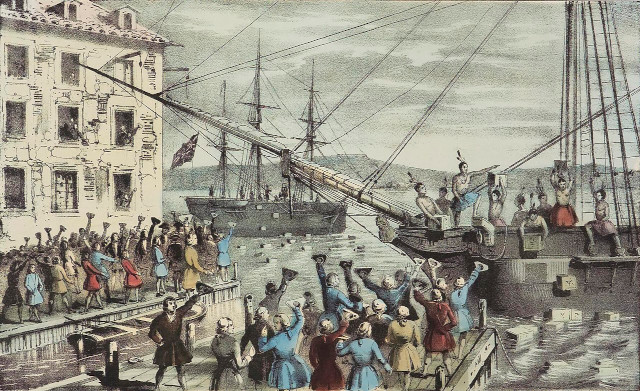1763-1783: Library of Congress
Until the end of the Seven Years' War in 1763, few colonists in British North America objected to their place in the British Empire. Colonists in British America reaped many benefits from the British imperial system and bore few costs for those benefits. Indeed, until the early 1760s, the British mostly left their American colonies alone. The Seven Years' War (known in the United States as the French and Indian War) changed everything. Although Britain eventually achieved victory over France and its allies, victory had come at great cost. A staggering war debt influenced many British policies over the next decade. Attempts to raise money by reforming colonial administration, enforcing tax laws, and placing troops in America led directly to conflict with colonists. By the mid-1770s, relations between Americans and the British administration had become strained and acrimonious.
THE REVOLUTION IN America, when it came, began not with the English colonists but with the people over whom they ruled. Long before shots were fired at Lexington and Concord, long before George Washington crossed the Delaware, long before American independence was thought of, or even thinkable, a revolutionary tradition was forged, not by the English in America, but by Indians waging wars and slaves waging rebellions. They revolted again and again and again. Their revolutions came in waves that lashed the land. They asked the same question, unrelentingly: By what right are we ruled?
[These Truths page 55]
By 1750, even though the overwhelming majority of migrants to England’s colonies had. gone to the Caribbean, four out of every five people living in British America lived in one of the thirteen mainland colonies. This ratio was a consequence of different rates of mortality in different parts of Britain’s American empire. Migrants to the Caribbean died in heaps. In New England, English settlers enjoyed very long lives. The southern colonies had more in common with the Caribbean: a black majority and a high mortality rate. The middle colonies were mixed, a stew of Scots, Irish, English, Dutch, Germans, and Africans, a population healthier than that of the Caribbean but not as healthy as that of New England. Yet for all their differences, by some measures the mainland colonies were becoming more alike in the middle of the eighteenth century: “I found but little difference in the manners and character of the people in the different provinces I passed thro,” wrote the Scottish doctor Alexander Hamilton in 1744, after making a tour on horseback with his African slave, Dromo, from Maryland to Maine.
[These Truths page 67]
See the French and Indian War, from Wikipedia:
The French and Indian War (1754–1763) was a theater of the Seven Years' War, which pitted the North American colonies of the British Empire against those of the French, each side being supported by various Native American tribes.
...
The British colonists were supported at various times by the Iroquois, Catawba, and Cherokee tribes, and the French colonists were supported by Wabanaki Confederacy members Abenaki and Mi'kmaq, and the Algonquin, Lenape, Ojibwa, Ottawa, Shawnee, and Wyandot (Huron). Fighting took place primarily along the frontiers between New France and the British colonies, from the Province of Virginia in the south to Newfoundland in the north. It began with a dispute over control of the confluence of the Allegheny River and Monongahela River called the Forks of the Ohio, and the site of the French Fort Duquesne at the location that later became Pittsburgh, Pennsylvania.
See Pontiac's War:
Pontiac's War (also known as Pontiac's Conspiracy or Pontiac's Rebellion) was launched in 1763 by a confederation of Native Americans who were dissatisfied with British rule in the Great Lakes region following the French and Indian War (1754–1763).
The war began in May 1763 when Native Americans, alarmed by policies imposed by British General Jeffrey Amherst, attacked a number of British forts and settlements. Nine forts were destroyed, and hundreds of colonists were killed or captured, with many more fleeing the region.
Warfare on the North American frontier was brutal; the killing of prisoners, the targeting of civilians, and other atrocities were widespread. In an incident that became well-known and frequently debated, British officers at Fort Pitt attempted to infect besieging Indians with blankets that had been exposed to smallpox.

 Excerpts from These Truths, pages 80-91:
Excerpts from These Truths, pages 80-91: